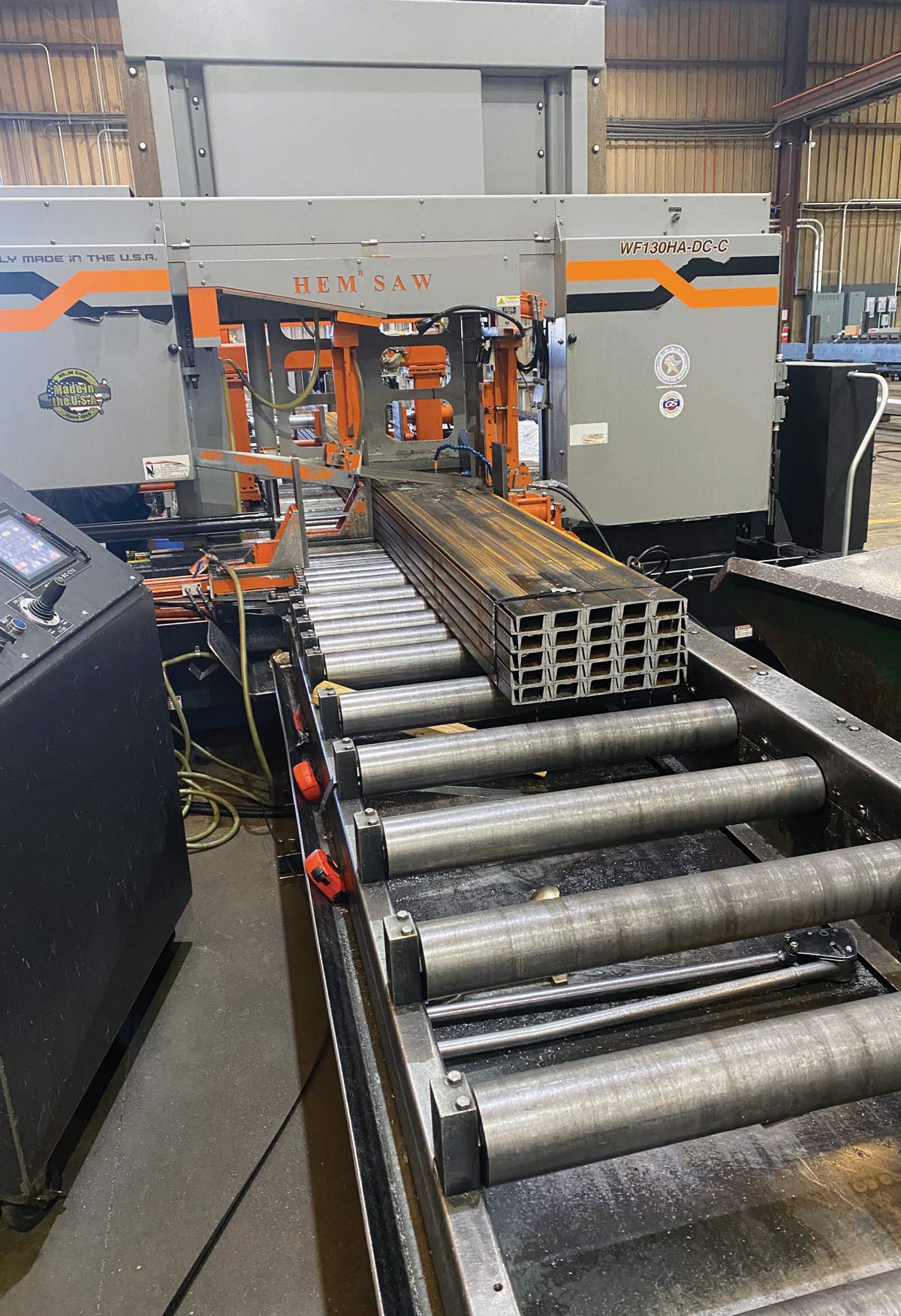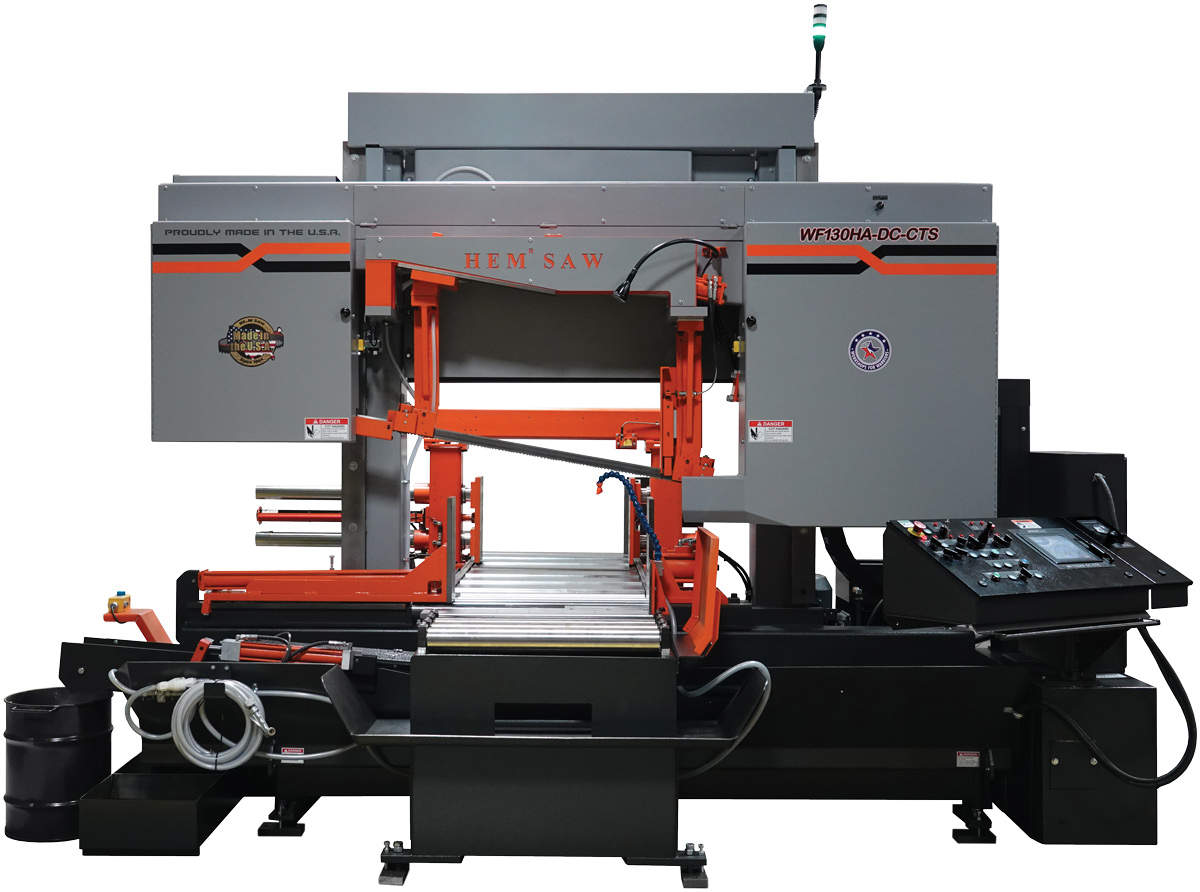Implementation

ith its sawing department operating around the clock five days a week plus an eight- to 10-hour shift on Saturdays, West Memphis Steel Corp. found that a manual band saw doesn’t cut it anymore and needs all its machines to be automatic moving forward, says Josh Stewart, the company’s maintenance manager. Automatic band saws enable a faster cutting process while maintaining part accuracy, even for complex sawing operations, compared with manual and semiautomatic models. In addition, jobs can be combined into a program and run in the order the operator selects.
“The very first machine we purchased was a manual machine. Since then, we’ve seen that everything needs to be automated. It reduces downtime due to errors with cuts,” Stewart says about an automatic band saw. “Once you set the program, the saw works really well.”
The manual band saw, installed in 2015, is a WF130 from Pryor, Oklahoma-based HE&M Inc. Stewart says WMS still uses the saw but is looking to replace it this year as the Arkansas-based service center updates and expands its equipment lineup. WMS also has four VT140 automatic band saws from HE&M and plans to purchase more automatic models. “We will have a total of nine HE&M saws by the end of the year.”
WMS offers an extensive array of products, including channels, angles, plates, pipes, round bar, beams and tubing, primarily made of grade 50, 55 and A36 steel. “That’s our wheelhouse,” Stewart says.
Like other service centers, WMS’s business is customer-driven. “When a customer comes and just needs four or five pieces of channel cut, we will do that,” Stewart says.
Some of the HE&M saws at WMS have the auto index, or bar feed, option to assist with the cut quality. Paul Beha, product manager at HE&M, notes that an automatic bar feed indexes a part to the desired lengths and enhances efficiency when cutting multiple parts of the same length or multiple parts of varying lengths out of the same piece.
“If the saws are designed correctly and make provisions for problems that can occur during the indexing, the part length will be extremely accurate,” Beha says. For example, a saw provides greater accuracy on cut lengths if it can prevent band straps on bundles or crooked parts from catching in vises as the material passes through. “The WF series saws have bidirectional vises, and both sides of the vises open during the feed cycle, which lessens the chance for bundle straps or crooked stock from hanging up.”
 We will have a total of nine HE&M saws by the end of the year.
We will have a total of nine HE&M saws by the end of the year. 
Stewart says, “If we have a specific part and want to cut to a specific length, we can hold our tolerances to within ±0.0625 inches and cut faster. There is not much room for error.”
Other HE&M saws can perform both right and left miter cuts. The ability to cut miter angles in both directions from a straight 90-degree cut is imperative for many operations that are cut to order, Beha says. In fact, that ability “is critical to making a profit. HE&M has automatic, programmable vertical saws in a variety of capacities that make automatic cuts of varying angles and lengths.”
Stewart adds, “You can put the correct programs in and chain them together, where you don’t have to trim-cut each individual part. The automation works very well with the saw, where you have limited waste.”

“They didn’t offer that and now they do,” Stewart says. “The powered lift loader can move the bundle into the blade. It helps the operator to cut the number he needs with the least amount of strain.”
Beha adds, “The bottom line is that powered cross transfers, in conjunction with powered roller tables, which WMS has, allow for the material to be moved onto the infeed and off the outfeed of the saw system efficiently, using less manpower and with far less demand on an overhead crane or forklift.”
When purchasing a band saw, Stewart says WMS orders a complete system, which includes a powered chip conveyor. When a band saw arrives at his facility, Stewart says the maintenance team removes it from the truck and sets it up before HE&M commissions the saw.
“Everything is ready when they come in. All they do to commission a saw is a little bit of leveling, double checking everything we did and in two days we’re up and running full production.”
Lead time for a new band saw is 12 to 14 weeks, and WMS orders HE&M equipment from Gulf State Saws & Machine Co. Inc. in Hueytown, Alabama, which also supplies parts. When an issue arises, Stewart says he can troubleshoot over the phone with HE&M’s service department. “A lot of times, I can fix it and they don’t have to send someone who is five hours away. They just send me the parts and I take care of it.”
To accommodate the expanding sawing department, which has about 10 workers, Stewart says the company purchased a 100,000-sq.-ft. building, which includes overhead cranes for loading material into the saw. “We have a very good process flow.”
That efficiency will help meet customers’ needs as more HE&M saws come online, Stewart says. “With the addition of these other saws, we’ll be able to get the product to our customers a little faster and make sure customers are taken care of. We try to get orders out within 24 to 48 hours.”